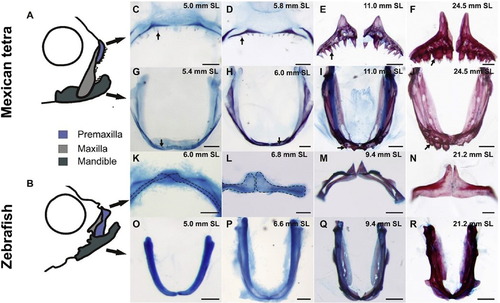Fig. 1
- ID
- ZDB-FIG-160922-19
- Publication
- Hammer et al., 2016 - What shapes the oral jaws? Accommodation of complex dentition correlates with premaxillary but not mandibular shape
- Other Figures
- All Figure Page
- Back to All Figure Page
|
Morphological changes of oral jaws throughout growth. A-B) Schematics showing the oral jaws of the adult Mexican tetra (Astyanax mexicanus) and zebrafish (Danio rerio). The oral jaws consist of the premaxilla (blue), maxilla (light grey) and mandible (dark grey). C-R) Alizarin red and Alcian blue stained oral jaws of the Mexican tetra and zebrafish C-J) Astyanax mexicanus from 5.0 mm SL to 24.5 mm SL. Arrows indicate teeth. K-R) Danio rerio from 6.0 mm SL to 21.2 mm SL. K and L are outlined with hatched lines to help visualize the shape of the premaxilla. Scale bars are 100 µm in C-D, G-H, K, L, O-P, 200 µm in M and Q, 250 µm in E, F, I, J, N, and 500 µm in R. |
Reprinted from Mechanisms of Development, 141, Hammer, C.L., Atukorala, A.D., Franz-Odendaal, T.A., What shapes the oral jaws? Accommodation of complex dentition correlates with premaxillary but not mandibular shape, 100-8, Copyright (2016) with permission from Elsevier. Full text @ Mech. Dev.

